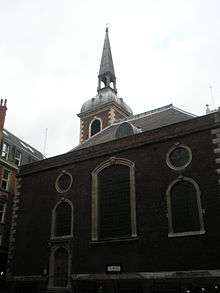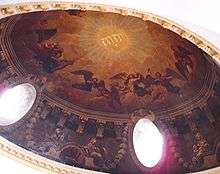St Mary Abchurch
| St. Mary Abchurch | |
|---|---|
 The interior of St Mary Abchurch | |
| Country | United Kingdom |
| Denomination | Anglican |
| Churchmanship | Traditional Catholic |
| Architecture | |
| Heritage designation | Grade I listed building |
| Architect(s) | Sir Christopher Wren |
| Style | Baroque |
St Mary Abchurch is a Church of England church off Cannon Street in the City of London. Dedicated to the Blessed Virgin Mary, it is first mentioned in 1198–1199. The medieval church was destroyed in the Great Fire of London in 1666, and replaced by the present building.
History
Medieval church
The church dates back to the twelfth century[1] and is dedicated to the Virgin Mary.[2] The additional name "Abchurch" may be a variant of "Upchurch", referring to its position on comparatively high ground.[3]
The patronage of the church belonged to the convent of St Mary Overy, Southwark, until around 1455, when it passed to the master and chaplains of the college of Corpus Christi at the church of St Laurence Pountney.[2] After the Reformation, Archbishop Parker persuaded Elizabeth I to grant the church to his college, Corpus Christi, Cambridge, which has appointed the incumbent ever since.
"Restored and beautified" in 1611 at the cost of the parishioners,[2] St Mary's was destroyed in the Great Fire of London of 1666.[4]
Rebuilding
The church was rebuilt by the office of Sir Christopher Wren in 1681–1686.[4] The parish was united with that of the nearby church of St Laurence Pontney, also destroyed in the Great Fire but not rebuilt.[2]
Wartime damage and repair
A bomb hit the church in September 1940 during the London Blitz. The greatest damage was to the dome. W. Godfrey Allen repaired the church between 1948–1953.
The dome was restored by E. W. Tristan, and work on it was completed after his death in 1952 by the artist Walter Hoyle.[5] Many sources describe the reredos as having been shattered into many pieces by the bombing and then carefully restored. In fact it was removed from the church by order of the church wardens, and kept in a place of safety for the duration of the war.[6] The church was designated a Grade I listed building on 4 January 1950.[7]
Exterior

The church has a red brick exterior with stone dressings.[8] There is a four-storey, 51-foot-high tower with a leaded spire. The church was originally intended to be much larger, with a structure similar to St. Stephen Walbrook, however for reasons unknown it was rebuilt on a smaller scale under the supervision of Robert Hooke.[9]
Interior


The ceiling of the church takes the form of a dome, pierced by four windows. It springs from four plain brick walls, has no external thrusts and measures more than forty feet across. It was painted with the present decorative scheme in 1708, when the whole church went under repair and beautification.[1] The artist was almost certainly William Snow, a member of the Painter-Stainers' Company, who lived in a house just to the north of the church; the church's accounts from the time list payments totalling £170 to a "Mr Snow", without, however, specifying the services rendered.[5] Painted in oils directly on the plaster, the decorations are divided in two horizontally by a painted Trompe-l'œil cornice. Above this a choir of angels and cherubs in adoration surrounds a golden glow, in the centre of which it the name of God in Hebrew characters. Below it are eight seated female figures painted in monochrome in imitation of sculpture; their precise symbolism has been variously interpreted.[5] The painting was restored once in the 18th century and twice in the 19th.[5][10]
The pulpit is by William Grey, and the door cases, a font cover, rails and Royal Arms are by William Emmett. Its grand altar-piece is by Grinling Gibbons.[11] Gibbons' original bill for what he called the 'Olter Pees' was rediscovered in the Guildhall Library in 1946. The motif of the gilded 'Pelican in her piety' makes its appearance both on the reredos and in the original copper weathervane made by Robert Bird, which was relocated to sit over the north door after being removed from the spire for safety reasons. Also to be seen there are original high box pews on three sides of the church. The church was without an organ until 1822, when public subscription allowed one to be built by J.C. Bishop. This sustained serious bomb damage during the Second World War and a new organ was made by N. P. Mander in the 1950s, using the 1717 organ casing once belonging to All Hallows, Bread Street.[12]
The remains of the former Lord Mayor of London Peter Perchard and his family are buried at St Mary Abchurch.[13]
See also
References
- 1 2 "St Mary Abchurch". Mark McManus. Retrieved 10 April 2009.
- 1 2 3 4 Newcourt, Richard (1708). Repetorium Ecclesiasticum Parochiale Londinense. 1. London. pp. 430 –1.
- ↑ Godwin, George; John Britton (1839). "St Mary's Abchurch". The Churches of London: A History and Description of the Ecclesiastical Edifices of the Metropolis. London: C. Tilt. Retrieved 8 October 2011.
- 1 2 Pevsner, Nikolaus; Bradley, Simon (1998). London: the City Churches. New Haven,: Yale University Press. ISBN 0-300-09655-0.
- 1 2 3 4 Smith, Eric E.F. (1958). "The Painted Ceiling of St Mary Abchurch". Transactions of the London and Midddlesex Archaeological Society. 19, part 3.
- ↑ "A Reredos Riddle solved?" (PDF). City Events. Friends of the City Churches. February 2014. Retrieved 9 December 2014.
- ↑ Historic England. "Details from image database (199266)". Images of England. Retrieved 23 January 2009.
- ↑ Betjeman, John (1967). The City of London Churches. Andover: Pitkin. ISBN 0-85372-112-2.
- ↑ Jeffery, Paul (1996). 'The City Churches of Sir Christopher Wren. Continuum Books. ISBN 978-1-847250-14-8.
- ↑ George Godwin and John Britton, in their Churches of London (1838–1839), name Sir James Thornhill as the painter without citing any documentary evidence; this attribution is repeated by many later authors. See Smith, p.172
- ↑ Cobb, G. The Old Churches of London. London: Batsford (1942).
- ↑ Heulin, G. (1996). 'Vanished churches of the City of London. London: Guildhall Library Publications.
- ↑ William Berry (1815). The History of the Island of Guernsey. Longman, Hurst, Rees, Orme, and Brown. pp. 149–.
External links
- Description of St Mary Abchurch from Our Past History
- 360° Panorama inside St Mary Abchurch
| Wikimedia Commons has media related to St Mary Abchurch. |
Coordinates: 51°30′42.02″N 0°5′18.05″W / 51.5116722°N 0.0883472°W